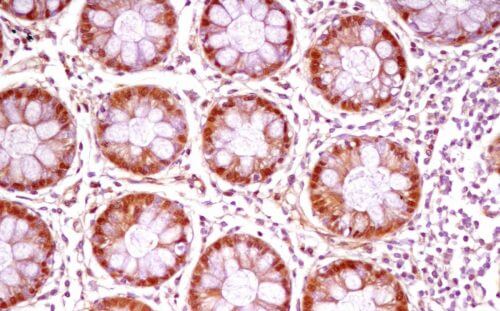Weizmann Institute of Science scientists have discovered a method to activate the body's natural defense mechanism against inflammatory bowel diseases

Inflammatory bowel diseases are very difficult to treat, because they arise from many and varied factors - from genetic predisposition, through the composition of intestinal bacteria, to poor activity of the immune system. A new study by scientists at the Weizmann Institute of Science, recently published in the scientific journal Cell Reports, suggests bypassing this complexity by activating the body's natural defense mechanism.
The research, which was led by veterinarian Dr. Noa Stettner, a research student in Dr. Ayelet Erez's laboratory in the Department of Biological Control, focused on nitric oxide (NO), a molecule involved in the transmission of signals in many biological processes. In the past, scientists tried to find out what role nitrous oxide plays in Crohn's disease and ulcerative colitis, and whether it can be used as a medicine, but the studies produced conflicting results: under certain circumstances, nitrous oxide did ease the inflammation in the intestine, but under other circumstances it made it worse. The institute's scientists hypothesized that these findings are due to the fact that nitric oxide affects different types of cells in the intestine differently. To test this hypothesis, they blocked nitric oxide production in transgenic mice - once in the cells of the inner lining of the intestine, and once in the cells of the immune system. They found that intestinal inflammation worsened when the production of nitric oxide was blocked in the mucosal cells. On the other hand, there was relief in the inflammation when the production of nitrogen oxide in the cells of the immune system was blocked, especially in large cells called macrophages.
The scientists concluded from this that it is possible to treat intestinal infections by selectively increasing the levels of nitrogen oxide in the cells of the inner lining. They relied on a previous study by Dr. Erez, in which it was found that an enzyme called ASL plays a central role in the production of nitric oxide. This enzyme is responsible for the production of the amino acid arginine, the raw material from which the body produces nitric oxide. To start the production mechanism of arginine in the body, the scientists used two natural components: pistin, which increases the levels of ASL in the body (it is found in apples, persimmons, strawberries and other fruits and vegetables), and citrulline, which increases the activity of ASL (it found in watermelon, beets, spinach and other plants). Dr. Stettner explains: "We hoped that if we made the body produce the people ASL and strengthened its activity, the enzyme would cause the production of nitric oxide in places where it brings benefits, and not in places where it could be harmful."
"We trusted the body to activate its natural healing mechanisms. We provided him with the building blocks, and let him produce the oxygenated nitrogen in exactly the amount needed and in the right place."
The method was successful: the two food additives together caused the mice to produce nitrogen oxide only in the cells of the inner lining of the intestine. And the main thing: in these mice there was a significant relief of intestinal inflammation. Furthermore, thanks to this treatment, an improvement was also recorded in conditions of colon cancer, which is adversely affected by severe inflammation in the intestine. When the scientists gave the two food supplements to mice with colon cancer, not only did their intestinal inflammation ease, but the tumors even shrank. "We trusted the body to activate its natural healing mechanisms," says Dr. Stettner. "We provided him with the building blocks, and let him produce the oxygenated nitrogen in exactly the amount needed and in the right place."
If future studies show that the method increases the levels of nitric oxide in the cells of the intestinal lining in humans as well, it may help treat inflammatory bowel diseases, and perhaps even alleviate conditions that are their complications, including colon cancer. Since the method relies on the use of food supplements sold without a doctor's prescription, it is expected to be easy to implement.
The following also participated in the study: Yulia Frog, Dr. Alon Zilberman, Dr. Alona Sarver and Dr. Narin Carmel-Niederman from the Department of Biological Control; Dr. Chava Rosen, Dr. Biana Bernstein, Dr. Shiri Gur-Cohen, Dr. Merav Pevsner-Fischer, Dr. Niv Zamora and Prof. Stefan Jung from the Department of Immunology; Dr. Raya Eilam, Dr. Inbal Biton and Prof. Alon Hermlin from the Department of Veterinary Resources; Dr. Alexander Brandis from the Department of Life Sciences Research Infrastructures; Dr. Keren Behar Halpern from the Department of Molecular Biology of the Cell; Dr. Ram Mazkeret from Tel Aviv University; Dr. Jillian Denk from the Hebrew University of Jerusalem; Dr. Diego Di Bernardo and Dr. Nicola Brunti-Fieri from Federico II University in Naples, Italy; and Dr. Murli Pharmacomer and Dr. Sandesh Nagmani from Baylor College of Medicine in Boston, Texas.

One response
I was unable to send the article to a young Crown patient
Just today I discovered the science and I got carried away in an addictive way, not only to the quizzes but mainly to the articles and articles from the American Scientific and others
Looking for information on cpap
Adenocarcinoma lung cancer
“”””””””””Squamous